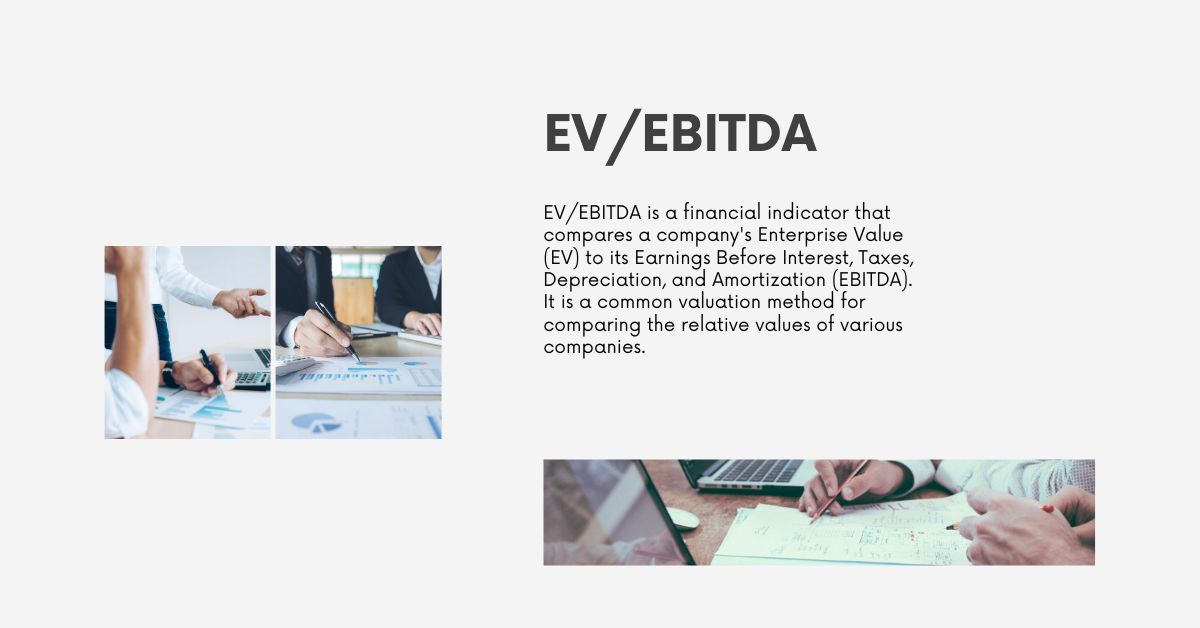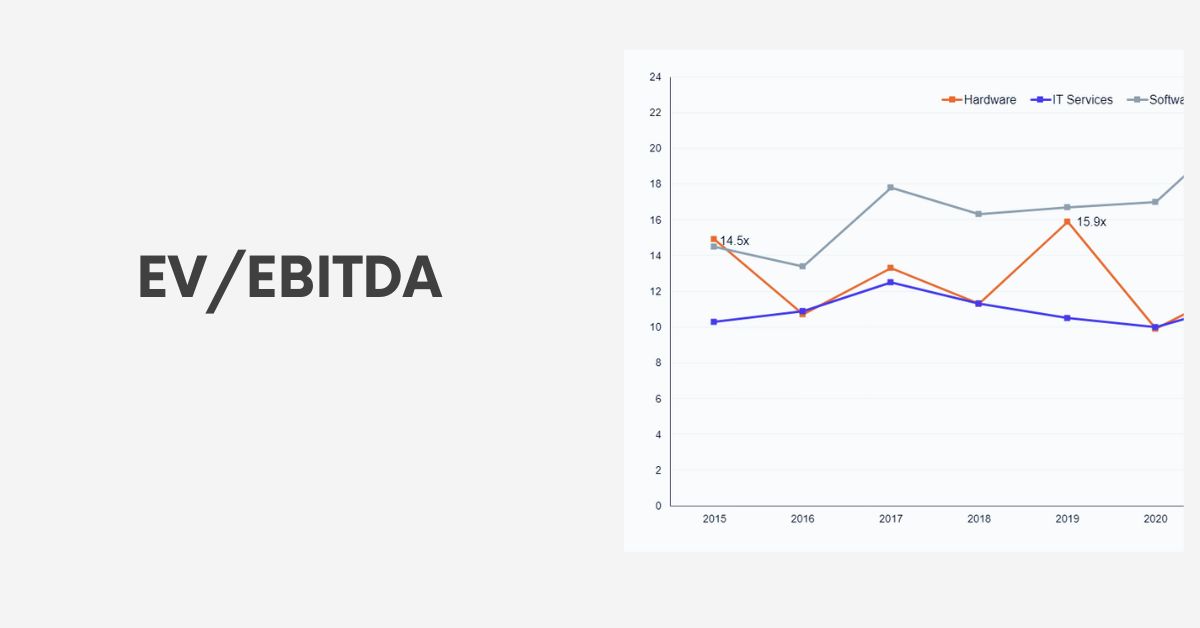Companies of all sizes and industries aim for financial success and long-term expansion. Enterprises, from startups to large corporations, constantly assess their operations and financial data in order to remain competitive and fulfill their goals.
In this sense, investors and analysts utilize an essential financial number to assess a company’s performance: the enterprise multiple (EV/EBITDA). This ratio is an important tool for investors and analysts since it allows them to measure a company’s financial health and profitability.
Understanding this ratio can help business executives make more educated decisions and manage their processes to increase profitability.
What is Ev\Ebitda?

EV/EBITDA is a financial indicator that compares a company’s Enterprise Value (EV) to its Earnings Before Interest, Taxes, Depreciation, and Amortization (EBITDA). It is a common valuation method for comparing the relative values of various companies.
Enterprise value is the total cost of owning a firm, which includes market capitalization, debt, and preferred equity. EBITDA is a company’s operating profit before non-cash charges such as depreciation and amortization.
By dividing EV by EBITDA, you may calculate how many times a company’s operational earnings are worth its overall value. A lower EV/EBITDA ratio typically indicates that a company is undervalued, whereas a greater ratio may imply that it is overpriced. When assessing this indicator, it is critical to take into account industry-specific benchmarks and other considerations.
EV/EBITDA Formula
The formula for EV/EBITDA is:
EV/EBITDA = Enterprise Value / EBITDA- Enterprise Value (EV) = Market Capitalization + Debt – Cash
- EBITDA = Earnings Before Interest, Taxes, Depreciation, and Amortization
What is the EV/EBITDA Multiple Used For?
The EV/EBITDA multiple is a popular valuation measure for comparing the relative worth of several businesses. It is especially effective for:
- Comparing companies in the same industry: Because EV/EBITDA normalizes for factors such as debt and non-cash expenses, it allows for more consistent comparisons of companies with diverse capital structures and accounting processes.
- Assessing a company’s overall value: A lower EV/EBITDA ratio typically indicates that a company is undervalued, whereas a greater ratio may imply that it is overpriced. When assessing this indicator, it is crucial to take industry-specific standards and other considerations into account.
- Evaluating the appeal of a possible acquisition: By comparing a target company’s EV/EBITDA to the industry average, investors can determine if it is valued at a premium or a discount.
- Monitoring a company’s success over time: By tracking changes in a company’s EV/EBITDA ratio, investors can determine whether its valuation is growing more or less appealing.
What is EV?
Enterprise value (EV) is a financial term that measures the total cost of acquiring a firm. It contains the company’s market capitalization, debt, and preferred equity. Essentially, EV represents the total amount an investor must pay to buy the company’s assets and activities.
EV is a more comprehensive valuation tool than market capitalization because it considers the company’s financial structure and possible liabilities. It is frequently used to compare the relative value of different businesses, particularly those with variable degrees of debt.
What is Ebitda?
EBITDA is a word that stands for Earnings Before Interest, Taxes, Depreciation, and Amortization. It is a financial indicator that calculates a company’s operating profit before deducting non-cash costs such as depreciation and amortization.
EBITDA provides a more accurate representation of a company’s underlying business performance by focusing on its core businesses. It is commonly used to compare companies in the same industry since it can help to equalize variances in accounting processes and capital structures.
Want to know more about Ebitda? You can read this article: What is EBITDA? A Beginner’s Guide to This Important Financial Metric
Comparison of Ev|Ebitda
| Factor | EV/EBITDA | Explanation |
| Focus | Company’s overall value | Operating profitability |
| Components | Market capitalization, debt, cash | Operating income, depreciation, amortization |
| Interpretation | Lower is generally better | Higher is generally better |
| Usage | Comparing companies, assessing valuation | Analyzing operating efficiency |
| Considerations | Industry-specific benchmarks, capital structure | Non-cash expenses, growth prospects |
Advantages and Disadvantages of EV/EBITDA
| Advantage | Disadvantage |
| Compares companies with different capital structures: EV/EBITDA normalizes for differences in debt and equity, making it easier to compare companies with varying levels of debt. | Ignores capital expenditures: EBITDA doesn’t consider capital expenditures, which can be important for companies that require significant investments to maintain their operations. |
| Focuses on core operations: By excluding non-cash expenses like depreciation and amortization, EV/EBITDA provides a clearer picture of a company’s underlying business performance. | Can be misleading for companies with high depreciation: If a company has high depreciation expenses, its EBITDA might be inflated, leading to a misleading valuation. |
| Easy to calculate and understand: The formula for EV/EBITDA is relatively simple, making it accessible to investors of all levels. | Doesn’t account for differences in revenue quality: EV/EBITDA doesn’t distinguish between revenue that is recurring and sustainable versus revenue that is non-recurring or unsustainable. |
| Widely used: EV/EBITDA is a popular valuation metric, making it easy to compare companies within an industry. | Can be influenced by accounting practices: The calculation of EBITDA can be influenced by different accounting standards and practices, which can make comparisons less reliable. |
What is a Good Ebitda Ratio?
The definition of a “good” EV/EBITDA ratio varies by industry and market conditions. A smaller ratio shows that a company is undervalued, whereas a greater ratio may indicate that it is overvalued. However, while reading this indicator, it is important to consider industry-specific benchmarks and other criteria.
For example, in a cyclical industry like technology, a higher EV/EBITDA ratio may be acceptable due to the possibility of large growth. whereas a smaller percentage may be predicted in a more mature industry, such as utilities. To better understand a company’s relative valuation, compare its EV/EBITDA ratio to that of its peers and watch changes over time.
What Does High Ev Ebitda Mean?
A high EV/EBITDA ratio usually means that a company is overvalued. This suggests that investors are willing to pay more for the company’s future profit potential. However, a high EV/EBITDA ratio does not necessarily indicate that a company is overvalued. It could also indicate great growth potential or a unique company approach.
Factors to consider while considering a high EV/EBITDA ratio are:
- Industry-specific benchmarks: Compare the company’s EV/EBITDA ratio to that of its industry peers.
- Growth prospects: If a company has excellent growth potential, a higher EV/EBITDA ratio may be warranted.
- Unique business model: A company with a unique business model or competitive edge may be able to fetch a higher valuation.
- Capital structure: The company’s capital structure (debt vs. equity) might influence its EV/EBITDA ratio.
Is a Lower Ev Ebitda Better?
In general, a lower EV/EBITDA ratio is considered better because it indicates that a company is cheap. This means that investors pay less per dollar of the company’s operating earnings. However, a low EV/EBITDA ratio does not automatically imply a bargain. Industry-specific benchmarks, growth expectations, and capital structure are all important factors to examine.
Several factors can contribute to a low EV/EBITDA ratio:
- If a company is having financial troubles, investors may be less ready to pay a premium for future earnings.
- The market may overreact to unfavorable news, resulting in a drop in a company’s stock price and a lower EV/EBITDA ratio.
- The company is simply undervalued. In some situations, a firm may be legitimately undervalued, which means that its stock price is lower than it should be given its fundamentals.
What if Ev Ebitda is negative?
If EV/EBITDA is negative, this indicates that the company’s Enterprise Value (EV) is negative. This might happen when a corporation has a large quantity of cash and marketable securities that surpass its entire debt.
While a negative EV/EBITDA may appear uncommon, it is not always a bad sign. In fact, it might be a good sign of a company’s financial stability. A negative EV/EBITDA ratio indicates that the company has a solid balance sheet and may use its extra capital to purchase other companies or return value to shareholders via dividends or buybacks.
When examining a firm with a negative EV/EBITDA, other elements to evaluate are its growth prospects, competitive position, and overall business strategy.

